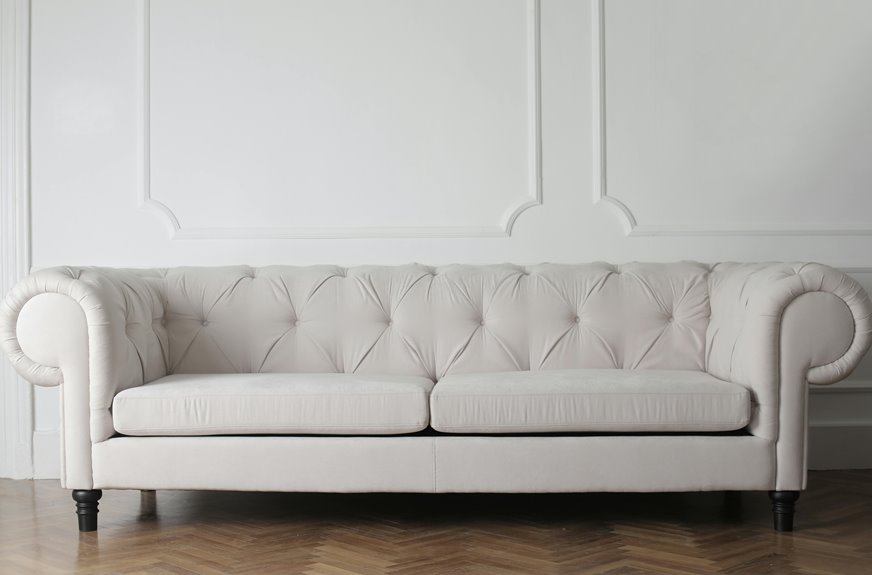To clean your white faux leather sofa and remove yellowing, start by mixing equal parts water and white vinegar, then lightly spray the stained areas. Let it sit for five minutes before gently scrubbing with a soft brush or microfiber cloth. Wipe off with a damp cloth and repeat if necessary. Regular dusting, avoiding direct sunlight, and using mild cleaners will help keep your sofa bright. Keep going for more tips on natural remedies and prevention tricks.
Table of Contents
Key Takeaways
- Mix equal parts water and white vinegar, spray on yellow stains, let sit 5 minutes, then gently scrub with a soft cloth or brush.
- Use mild soap or specialized faux leather cleaner and soft microfiber cloths to safely clean without damaging the sofa.
- Vacuum the sofa with a soft brush attachment before cleaning to remove dust and debris for better stain removal.
- Avoid direct sunlight exposure and use a dehumidifier to prevent further yellowing and discoloration of white faux leather.
- Regularly dust, clean, and rotate cushions to maintain the sofa’s brightness and prevent uneven yellowing over time.
Understanding the Causes of Yellowing on White Faux Leather
Although white faux leather looks pristine at first, it can quickly develop yellowing that’s frustrating to remove. You might wonder why this happens, and it mostly comes down to exposure.
Over time, your sofa faces sunlight, body oils, and environmental pollutants, all of which can cause the material to discolor. Heat and humidity also speed up this process, breaking down the synthetic fibers and triggering that yellow tint.
Additionally, using improper cleaning products can worsen the yellowing by reacting chemically with the faux leather. Understanding these causes helps you prevent further damage and tackle existing stains more effectively.
Essential Supplies Needed for Cleaning Your Sofa
To clean your white faux leather sofa effectively, you’ll need a few essential supplies on hand.
Having the right tools makes the process smoother and guarantees you don’t damage the material. Start by gathering these key items:
- Mild soap or specialized faux leather cleaner: Harsh chemicals can ruin the finish, so stick to gentle options designed for faux leather.
- Soft microfiber cloths: These won’t scratch the surface and are perfect for wiping away dirt and cleaning solutions.
- A soft-bristled brush or sponge: Useful for gently scrubbing stubborn spots without damaging the sofa.
With these supplies ready, you’re set to tackle dirt and yellowing safely and efficiently, preserving your sofa’s crisp white look.
Preparing Your Faux Leather Sofa for Cleaning
Gathering the right supplies sets you up for success when cleaning your white faux leather sofa.
Before you start, remove any cushions, throws, or blankets from the sofa. This clears the surface and prevents interference during cleaning.
Next, use a vacuum with a soft brush attachment to remove dust, dirt, and crumbs from crevices and seams.
Spot-check the sofa for any loose threads or tears to avoid worsening damage during cleaning.
Protect your work area by placing a drop cloth or old towel underneath the sofa.
Finally, test your chosen cleaning solution on a hidden area to verify it won’t discolor or damage the faux leather.
Once prepped, you’re ready to tackle those yellow stains confidently and safely.
Step-by-Step Guide to Removing Yellow Stains
Start by mixing a gentle cleaning solution of equal parts water and white vinegar in a spray bottle. Lightly spray the yellow-stained areas, avoiding saturation. Let it sit for 5 minutes to break down discoloration.
Then, gently scrub with a soft-bristled brush or microfiber cloth in a circular motion. Afterward, wipe the area with a clean damp cloth to remove residue. For persistent stains, repeat the process or try a paste made from baking soda and water, applying it carefully.
Remember to:
- Test the solution on a hidden spot first to prevent damage.
- Avoid harsh chemicals that can worsen yellowing.
- Always dry the sofa thoroughly with a soft towel to prevent moisture buildup.
Following these steps helps restore your sofa’s bright appearance effectively.
Tips for Maintaining the Brightness of White Faux Leather
To keep your white faux leather sofa looking bright, make dusting a regular habit and avoid placing it in direct sunlight.
You’ll also want to use gentle cleaners to prevent damage and discoloration.
These simple steps will help maintain its fresh, clean appearance.
Regular Dusting Routine
Although white faux leather looks stunning, it easily shows dust and dirt, so you’ll want to dust your sofa regularly to keep it bright and fresh.
Dust buildup can dull its appearance and even cause discoloration over time. To maintain that clean look, make dusting a simple habit. Use a soft, dry microfiber cloth to gently wipe the surface and remove loose particles.
For best results, follow these tips:
- Dust your sofa at least once a week to prevent grime accumulation.
- Use a handheld vacuum with a soft brush attachment for crevices.
- Avoid harsh chemicals that can damage the faux leather finish.
Avoid Direct Sunlight
Since white faux leather easily fades and discolors, you should keep your sofa out of direct sunlight whenever possible. Prolonged exposure to UV rays breaks down the material’s pigments, causing yellowing and dullness.
Position your sofa away from windows or use curtains and blinds to block harsh sunlight during peak hours. If moving the sofa isn’t feasible, consider applying UV-protective window film to reduce damage without sacrificing natural light.
Also, rotate cushions and sofa sections regularly to guarantee even exposure and maintain consistent color.
Use Gentle Cleaners
Many cleaning products contain harsh chemicals that can damage your white faux leather sofa’s surface and dull its brightness. To keep your sofa looking fresh, opt for gentle cleaners specifically designed for synthetic materials.
Avoid bleach, ammonia, or alcohol-based solutions, as they can cause discoloration or cracking.
When cleaning, try these safe options:
- Mild dish soap diluted in warm water
- A mixture of white vinegar and water in equal parts
- Commercial faux leather cleaners labeled non-toxic and pH-neutral
Always test any cleaner on a small, hidden area first to verify it doesn’t affect the color or texture.
Natural Remedies vs. Commercial Cleaners: What Works Best?
How do natural remedies stack up against commercial cleaners when it comes to cleaning your white faux leather sofa?
Natural remedies like vinegar, baking soda, and mild soap offer gentle, affordable options that are less likely to damage your sofa’s surface. They’re great for light stains and regular maintenance.
Natural remedies like vinegar and baking soda provide gentle, affordable care ideal for light stains and regular maintenance.
However, commercial cleaners are specifically formulated to tackle tough stains and yellowing, often providing quicker, more noticeable results. They usually contain ingredients designed to break down dirt and oils without harming faux leather.
If you prefer a chemical-free approach, natural remedies work well but might require more effort and repeated applications.
For stubborn yellowing or deep grime, commercial products may save you time and deliver a more thorough clean.
Ultimately, your choice depends on stain severity and your comfort with cleaning agents.
Preventative Measures to Avoid Future Yellowing
To keep your white faux leather sofa looking fresh, stick to a proper cleaning routine that prevents buildup and stains.
You’ll also want to control the environment by limiting exposure to direct sunlight and humidity, which can cause yellowing.
Taking these simple steps will help maintain your sofa’s bright, clean appearance over time.
Proper Cleaning Routine
Although white faux leather sofas can brighten any room, they require a consistent cleaning routine to prevent yellowing over time.
You should clean your sofa regularly to maintain its fresh appearance and extend its lifespan. Here’s how to keep your sofa looking pristine:
- Wipe down the surface weekly with a soft, damp cloth to remove dust and dirt.
- Use a mild soap solution once a month to gently clean stains without damaging the material.
- Avoid harsh chemicals or abrasive tools that can wear down the faux leather and cause discoloration.
Environmental Control Tips
Sunlight and heat are the main culprits behind yellowing on white faux leather sofas, so you’ll want to control their exposure.
Position your sofa away from direct sunlight or use curtains and blinds to reduce UV damage. Keep the room temperature moderate, avoiding placing the sofa near radiators or heat vents.
High humidity can also cause discoloration, so maintain proper ventilation and use a dehumidifier if needed.
Regularly dust and clean your sofa to prevent dirt buildup, which can contribute to yellowing over time.
By managing these environmental factors, you’ll help preserve your sofa’s pristine white look and extend its lifespan.
Taking these simple steps keeps your faux leather sofa looking fresh and vibrant for years to come.
Frequently Asked Questions
Can I Use Bleach to Clean White Faux Leather?
Bleach might seem like a magic wand, but you shouldn’t use it on your white faux leather—it can damage and discolor it. Instead, stick to gentle cleaners to keep your sofa looking fresh and bright.
How Often Should I Deep Clean My Faux Leather Sofa?
You should deep clean your faux leather sofa every 3 to 6 months. Regular cleaning keeps it looking fresh and prevents buildup. If you have pets or kids, consider cleaning more frequently to maintain its condition.
Is It Safe to Use a Steam Cleaner on Faux Leather?
You might think steam cleaners are magic wands, but they can seriously damage your faux leather! Don’t risk warping or cracking—stick to gentle, damp cloths and mild soap to keep your sofa looking flawless and safe.
Can Yellowing on Faux Leather Be Reversed Completely?
You might not be able to reverse yellowing on faux leather completely, but you can greatly reduce it by using gentle cleaners and conditioners. Consistent care helps, but some discoloration may be permanent due to material aging.
What Should I Do if My Sofa Has Mold or Mildew?
Noticed mold or mildew on your sofa? Don’t panic! You should mix equal parts water and vinegar, gently scrub the area, then wipe it dry. Isn’t it amazing how simple solutions can tackle tough problems?
- The Use of Nonwovens in Construction and Civil Engineering - July 11, 2025
- The Use of Nonwovens in Construction and Civil Engineering - July 11, 2025
- The Use of Nonwovens in Construction and Civil Engineering - July 11, 2025






